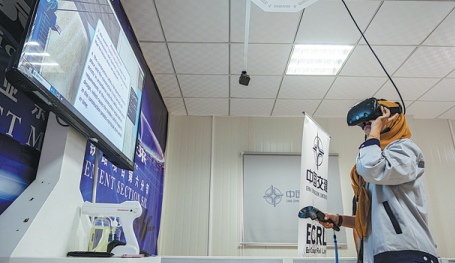SOEs Assisting Overseas Clients to Hit Green Goals
China's State-owned manufacturers and infrastructure project providers-a group of companies that have long been a thriving part of many countries' industrialization and urbanization processes-are increasingly applying digital solutions in the global market to meet demand from its clients and maintain robust growth.
SOEs such as China Railway Construction Corp Ltd, CBMI Construction Co Ltd and China Communications Construction Co Ltd have all introduced new platforms and technologies to improve construction and production efficiency in overseas markets via digital, networking and smart transformation and upgrading solutions.
They have already accelerated investment in strategic emerging industries, such as new energy vehicles, satellite navigation systems, e-commerce, 5G and other new types of information infrastructure in both domestic and foreign markets.
China Railway Construction Corp Ltd, one of the country's major rail construction contractors, said that digital technologies have been widely used in the construction of Lusail Stadium, the main venue of FIFA World Cup Qatar 2022.
Located about 15 kilometers north of Doha, Qatar's capital, the stadium can hold up to 80,000 spectators. It is the first World Cup venue to be contracted by a Chinese company and the largest China-built overseas professional venue with the largest spectator capacity.
It will host the final on Dec 18 as well as, among other matches, the first semifinal. The stadium's main body is already completed.
People approaching the stadium will notice a delicately decorated wall glimmering under the desert sun. It is made of triangular aluminum plates carved with more than 4,200 simulated enamel lantern patterns. The plates were made using 3D laser scanning technology and Building Information Modeling (BIM) solutions.
Liu Dawei, the project's manager, said that it is the first time BIM has been widely used by a Chinese company in an overseas ultra-large stadium for a global sporting event.
Liu explained that the essence of BIM technology is to build a virtual construction model and use it to guide construction and operations.
During construction, CRCC partnered with 110 large subcontractors from 15 countries to integrate high-quality technological resources and realize a coordinated design.
Promoting digital transformation is practical to improve SOE's businesses in global markets, especially in economies related to the Belt and Road Initiative, said Li Jin, chief researcher at the China Enterprise Research Institute in Beijing.
"Apart from responding to the government's call to accelerate the cultivation of world-class enterprises with a technological edge, it has great significance as it will help maintain the stability of the world's industrial and supply chains," Li said.
In Europe, CBMI Construction Co Ltd, a subsidiary of Beijing-based China National Building Material Group Co Ltd, said that its production line renovation project at the MK3 cement plant in France, contracted by the company, was completed and put into operation in the first quarter.
Based on smart construction methods integrating digital operations, smart equipment and remote technology, the plant is now a technically leading digital smart plant in Europe's cement industry.
The rotary kiln is a major equipment component of cement plants, and its installation was a key part of the renovation project.
According to Lin Dong, general manager of the company's French subsidiary, smart methods were used during hoisting and installation. The engineering site and its position were simulated through animation, through which the engineering space and positions of the rotary kiln body and the engineering vehicles were accurately confirmed as being of maximum efficiency.
Lin said such visualized engineering modeling helps workers understand their tasks and improves operational precision and efficiency.
Engineers collected data and information using unmanned aerial vehicles and sent the findings to a data center. The intelligent database then generated the best operational suggestions to help on-site engineers carry out further work.
Lin added that connections between the data center and the project were cut off when the project was completed, which guarantees the data security of the French client.
Managers and operators can study data such as distances between devices and operating times of bearings by touching digital screens. They can also directly send engineering commands via mission management platforms.
Thanks to the advanced technologies, production efficiency of the plant has increased to 5,000 metric tons of cement output on a daily basis.
Since France has set a strategy aiming to reach carbon neutrality by 2050, Lin said that the plant meets current low-carbon development requirements.

An employee of China Communications Construction Co Ltd takes safety training through augmented reality (AR) devices in Pahang state, Malaysia, in November. [Zhu Wei/Xinhua]



